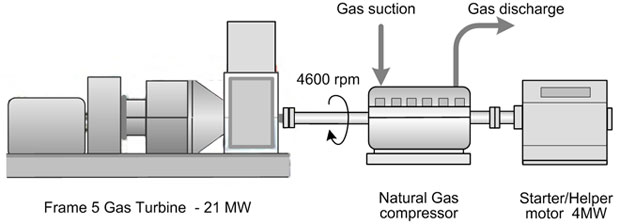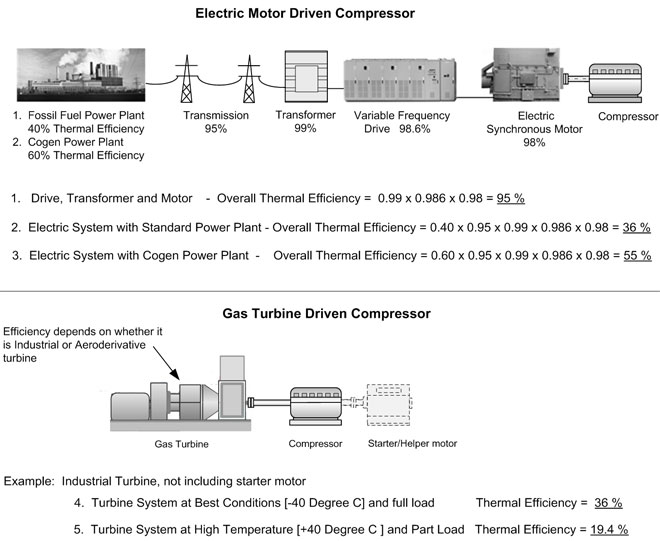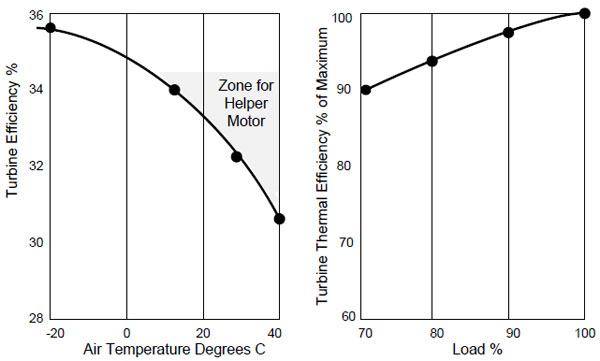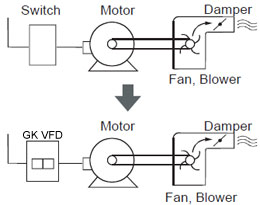Home » Applications » VFD for Compressor in oil and gas industry
VFD for Compressor in oil and gas industry
Large compressors and pumps are the backbone of the oil and gas industry. Compressor systems are found in applications such as gas pipeline boosting stations, refrigeration trains at liquefied natural gas (LNG) plants, and a variety of applications in petrochemical plants, and refineries.
Today, installations that use large axial flow or centrifugal compressors commonly have gas turbines as the prime mover. Gas turbines can run at high speed and have the convenience of using natural gas for fuel, which is often available at the site. Electric helper motors have been used in tandem to start the turbine and to provide additional power when the turbine power declines to less than the process demands.
In the past, large compression systems utilized only reciprocating engines or steam turbines as the prime movers. The advent of the gas turbine with power ranges of 10 – 100 MW led to today's situation where most compressor systems in this power range have a gas turbine prime mover.
Beginning in the late 1990's designs of VFD (Variable Frequency Drive) made it practical to use electric motors up to 100MW. Since then, large electric motors with VFDs have begun replacing gas and steam turbines for driving large compressors. In spite of power, speed, and fuel advantages of turbines as prime movers, the trend to electric motors and VFDs is accelerating and this paper discusses some reasons why the change makes economic sense.
Summary of variable frequency drive plus Electric motor advantages over a Gas Turbine
As highlighted earlier, the past experience of large compression systems has been using mechanical prime movers such as gas turbines. There has to be strong advantage in order to replace a mechanical prime mover in an industry where the operators and engineers have such a long history of mechanical expertise and experience. The advantages must translate into monetary and operational enhancement. The benefits of using VFDs are:

Figure 1. Compressor Drive consisting of Gas Turbine and Electric Starter/Helper Motor
Compressor Variable Frequency Drive
In Figure 2, an electric motor is started and run by a VFD. The starting current is controlled so that no large inrush occurs, which can result in overheating in the motor and a dip in the supply voltage. This capability of limiting inrush will save operations significant electrical charges. Generally, synchronous motors are employed for compressor power levels greater than 15 MW, though induction motors now range up to 25 MW. A speed increasing gearbox is typically required for standard speed motors like 1500/1800 rpm or 3000/3600 rpm motors. One of the advantages of using variable frequency drives on motors is that in many cases, the gear box can be eliminated by specifying a super high speed motor. Without a gearbox, the system efficiency increases 2%, however, there are tradeoffs with speed, cost, and power that have to be considered in order to determine if this is the best approach for the application.

Figure 2. Compressor Drive consisting of a VFD and Synchronous Motor
The two-pole motor shown in Figure 2 has a rated maximum speed of 4600 rpm for a 76.7 Hz input frequency, and is a direct drive solution with no gearbox. By using a high speed motor design with a variable frequency drive, motor speeds of up to 12,000 rpm can be achieved. Because the variable frequency drive controls the output speed, voltage, and motor torque, optimum control of the process is possible. Also, because the variable frequency drive has complete control of the load torque across the entire speed range, it is possible to start the process under loaded conditions. This enables the end user to avoid the gas being recycled, flared, or released in the atmosphere while the system is being started up. Sometimes these savings can be several hundred thousand dollars.
Energy Consumption
The main operating expense of the plant is the cost of fuel. This can be illustrated by comparing the thermal efficiencies of the turbine and the VFD system as shown below in case 1 and 4. The VFD system has a 95% efficiency and the industrial gas turbine has a 36% efficiency. The higher the efficiency, the lower the fuel expense.
When the energy efficiency of the electric power supply is included, the overall energy efficiencies are more equal, as shown in cases 2 and 4. If, on the other hand, the power is supplied by a co-gen plant then the VFD system has a much higher overall efficiency of 55%, see case 3.

Figure 3. Drive Efficiencies
Turbine Temperature and Load Effects
Gas turbines are sensitive to ambient temperatures. When the air temperature rises the efficiency and power decreases as shown in Figure 4. Turbines also lose efficiency at part load.

Figure 4. Temperature and Load Effects
Application Considerations when Selecting a Drive
When a major capital equipment purchase is being considered, the important considerations are:
Table 1. Comparison of Gas Turbine Drive with an Electric VFD
Conclusions
In summary, the advantages of using an electric motor and VFD instead of a gas turbine are as follows:
Today, installations that use large axial flow or centrifugal compressors commonly have gas turbines as the prime mover. Gas turbines can run at high speed and have the convenience of using natural gas for fuel, which is often available at the site. Electric helper motors have been used in tandem to start the turbine and to provide additional power when the turbine power declines to less than the process demands.
In the past, large compression systems utilized only reciprocating engines or steam turbines as the prime movers. The advent of the gas turbine with power ranges of 10 – 100 MW led to today's situation where most compressor systems in this power range have a gas turbine prime mover.
Beginning in the late 1990's designs of VFD (Variable Frequency Drive) made it practical to use electric motors up to 100MW. Since then, large electric motors with VFDs have begun replacing gas and steam turbines for driving large compressors. In spite of power, speed, and fuel advantages of turbines as prime movers, the trend to electric motors and VFDs is accelerating and this paper discusses some reasons why the change makes economic sense.
Summary of variable frequency drive plus Electric motor advantages over a Gas Turbine
As highlighted earlier, the past experience of large compression systems has been using mechanical prime movers such as gas turbines. There has to be strong advantage in order to replace a mechanical prime mover in an industry where the operators and engineers have such a long history of mechanical expertise and experience. The advantages must translate into monetary and operational enhancement. The benefits of using VFDs are:
- Reduced downtime because gas turbines require frequent maintenance while VFDs and motors require very little maintenance. This enables more production, lower maintenance expense, and improved productivity.
- Accurate speed control and process control allowing the most optimum plant flow balance to be obtained.
- Lower energy costs because the VFD and motor has a higher efficiency than most gas turbines, especially at part load.
- Zero CO2 and NOX emissions at the operating station and greatly reduced noise. This feature often makes electric prime movers the only selection in applications near urban regions or regions with existing air quality problems.
- Independent of ambient temperature. Gas turbines generate less power when the inlet air temperature rises since the air density is reduced and less oxygen reaches the combustion chambers. VFDs and motors are not affected by temperature.
- Lower capital equipment, spare parts and maintenance cost.
- Lead times of 9 - 12 months, depending on the motor design. Compared to a mechanical prime mover which can have 18 month lead time, this shorter lead time allows for a quicker production revenue gain.

Figure 1. Compressor Drive consisting of Gas Turbine and Electric Starter/Helper Motor
Compressor Variable Frequency Drive
In Figure 2, an electric motor is started and run by a VFD. The starting current is controlled so that no large inrush occurs, which can result in overheating in the motor and a dip in the supply voltage. This capability of limiting inrush will save operations significant electrical charges. Generally, synchronous motors are employed for compressor power levels greater than 15 MW, though induction motors now range up to 25 MW. A speed increasing gearbox is typically required for standard speed motors like 1500/1800 rpm or 3000/3600 rpm motors. One of the advantages of using variable frequency drives on motors is that in many cases, the gear box can be eliminated by specifying a super high speed motor. Without a gearbox, the system efficiency increases 2%, however, there are tradeoffs with speed, cost, and power that have to be considered in order to determine if this is the best approach for the application.

Figure 2. Compressor Drive consisting of a VFD and Synchronous Motor
The two-pole motor shown in Figure 2 has a rated maximum speed of 4600 rpm for a 76.7 Hz input frequency, and is a direct drive solution with no gearbox. By using a high speed motor design with a variable frequency drive, motor speeds of up to 12,000 rpm can be achieved. Because the variable frequency drive controls the output speed, voltage, and motor torque, optimum control of the process is possible. Also, because the variable frequency drive has complete control of the load torque across the entire speed range, it is possible to start the process under loaded conditions. This enables the end user to avoid the gas being recycled, flared, or released in the atmosphere while the system is being started up. Sometimes these savings can be several hundred thousand dollars.
Energy Consumption
The main operating expense of the plant is the cost of fuel. This can be illustrated by comparing the thermal efficiencies of the turbine and the VFD system as shown below in case 1 and 4. The VFD system has a 95% efficiency and the industrial gas turbine has a 36% efficiency. The higher the efficiency, the lower the fuel expense.
When the energy efficiency of the electric power supply is included, the overall energy efficiencies are more equal, as shown in cases 2 and 4. If, on the other hand, the power is supplied by a co-gen plant then the VFD system has a much higher overall efficiency of 55%, see case 3.

Figure 3. Drive Efficiencies
Turbine Temperature and Load Effects
Gas turbines are sensitive to ambient temperatures. When the air temperature rises the efficiency and power decreases as shown in Figure 4. Turbines also lose efficiency at part load.

Figure 4. Temperature and Load Effects
Application Considerations when Selecting a Drive
When a major capital equipment purchase is being considered, the important considerations are:
- Process and equipment to be driven – power levels, speed range, controllability
- Plant location – availability of utility or gas power, ambient conditions, environmental regulations
- Target plant availability – expected level of production and revenues based on the equipment MTBF and MTTR
- Flexibility of operation
- Capital expense – equipment, site construction, installation
- Operating expense – electric or gas power, maintenance, spares
Table 1. Comparison of Gas Turbine Drive with an Electric VFD
|
Decision Factor |
Gas Turbine |
Electric VFD |
VFD Advantages |
|
Minor maintenance schedule and duration |
Every 4,000-8,000 hrs. 6 -10 days downtime |
Every 25,000 hours, half day downtime |
Less downtime, more production; Lower maintenance expense |
|
Major over haul schedule and duration |
Every 20 -30,000 hours. 30 days downtime |
No major overhaul required |
Less downtime, more production Lower maintenance expense |
|
Reliability – MTBF hours |
4,000 to 10,000 hours |
28 years |
Less downtime, more production Lower maintenance expense |
|
Repair time - MTTR |
0.5 to 3 days |
0.5 hours |
Less downtime, more production Lower maintenance expense |
|
Variable speed |
Narrow speed range; large gas turbines range is 96-101% speed |
Wide, accurate variable speed control range, 69% to 105% speed |
Better process control Better flow balance in process |
|
Speed control |
Slow speed control response. Narrow speed control range |
Faster control response. Good energy efficiency at lower speeds |
Better speed control & plant flow balance bringing operating savings |
|
Maximum speed |
Typically 6,100 rpm |
3,600 rpm to as high as 12,000 rpm without a gearbox |
No need of additional lube oil system, can use the compressor lube oil system |
|
Starting |
Electric starter motor usually required, turbine start takes time |
Short starting time using the variable frequency drive. No bad effect on the power system. |
Shorter starting time. Increased production. |
|
Overall thermal energy efficiency |
Industrial Gas turbine 28-38%, Aeroderivative gas turbine 36-42% |
With power from utility plant - 36%. With power from co-gen plant - 55% |
Usually lower energy costs. Lower operating cost |
|
Variation in energy efficiency & power |
Efficiency & power drops with rising temperature, with falling speed; efficiency drops with decreasing load |
Efficiency is constant with temperature, speed, and load |
Helper motor is not required. Lower operating cost |
|
Power output level |
Up to 150,000 HP |
Up to 135,000 HP |
- |
|
Power supply |
Power source required to start turbine |
Reliable grid connection required |
- |
|
Emissions and noise |
High local CO2, CO, NOX emissions, and noise. May have to pay penalties |
VFD & motor have no emissions. Utility station controls its emissions |
No emissions. Smooth permitting process. Avoid complaints and penalties |
|
Initial equipment cost |
Turbine, piping and installation cost |
VFD cost somewhat lower than turbine cost |
Lower capital cost than turbine (Higher cost if power plant is built) |
|
Delivery time |
18 months |
Variable frequency drive has 8-12 months. Motor has 9-15 months |
Earlier delivery can provide project cost savings and earlier cash flow |
Conclusions
In summary, the advantages of using an electric motor and VFD instead of a gas turbine are as follows:
- The variable frequency drive has a 28 year MTBF, and only half day of downtime is required every 25,000 hours. The electric motor has a very high reliability (MTBF) and can run for years without maintenance. A gas turbine on the other hand requires maintenance every 4-8,000 hours and time consuming periodic major overhaul every three years. Therefore the VFD enables overall higher plant availability, greater gas throughput, and lower maintenance expense.
- Gas turbines vary in energy efficiency from 28% for industrial turbines up to 42% for zero-derivatives. The VFD has an energy efficiency of 94.5% and if the power station source has an efficiency of 40%, and the transmission 95%, then the overall VFD efficiency is 36%. If the power station has a 60% efficiency (Co-gen plant) then the VFD overall efficiency is 55%. Therefore, depending on the type of gas turbine used and the type of grid power used, the VFD can reduce energy costs. In addition, unlike a gas turbine, the power delivered by the VFD is not affected by a rise in ambient air temperature so a helper motor is not required.
- Delivery of a gas turbine is about 18 months whereas delivery of a variable frequency drive and synchronous motor is 9 -15 months. Delivery of a large high-speed two pole synchronous motor is about 15 months, and delivery of a 4-pole motor is 9 months. Therefore a VFD can be delivered in a shorter time than a gas turbine, which reduces the overall construction schedule.
- There are no local air quality issues created by a VFD, whereas the gas turbine generates CO2, CO, NOx, and other emissions, including noise. Noise from the VFD is low, less than 80 dBA (how to reduce noise?).
Post a Comment:
You may also like:
Featured Articles
Variable frequency drive application ...
 Variable Frequency Drive (VFD) can be used in lots of fields. Variable frequency drives are widely used to control the speed of ...
Variable Frequency Drive (VFD) can be used in lots of fields. Variable frequency drives are widely used to control the speed of ...
 Variable Frequency Drive (VFD) can be used in lots of fields. Variable frequency drives are widely used to control the speed of ...
Variable Frequency Drive (VFD) can be used in lots of fields. Variable frequency drives are widely used to control the speed of ...
VFD manufacturers

Will the CAPEX of VFD option be in the same range?